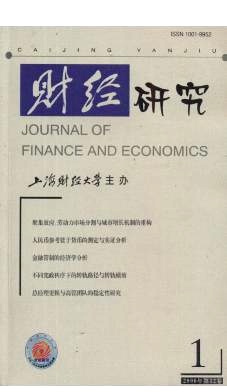人民币参考篮子货币的测定与实证分析
财经研究 2006 年 第 32 卷第 01 期, 页码:22 - 37
摘要
参考文献
摘要
自2005年7月21日起,我国开始实行以市场供求为基础、参考一篮子货币进行调节、有管理的浮动汇率制度。那么,篮子货币的构成如何,已成为国际社会关注的焦点。文章借鉴东南亚发展中国家汇率制度的变迁经验,联系我国的实际情况,采用协整理论以及基于VAR的Granger因果关系检验方法,构造了一种参考货币篮子。建议以美元(USD)、日元(JPY)、欧元(EUR)、港元(HKD)、韩元(KRW)、台湾元(TWD)、英镑(GBP)和澳元(AUD)等8种货币为篮子货币。实证结果显示:篮子货币汇率均为人民币实际有效汇率的Granger原因,它们与人民币实际有效汇率之间存在长期的协整关系。人民币汇率转向参考一篮子货币汇率较单一钉住美元具有很好的弹性。文章还针对稳定贸易为目标的政策选择,计算了篮子货币的最优权重。最后,基于我国的实际汇率数据,构建了人民币参考一篮子汇率模型,分析了参考一篮子汇率制的制度优势。
[1]丁剑平.亚洲各国汇市的波动特征[J].经济学(季刊),2003,(3):621~632.
[2]韩高峰.人民币汇率一篮子挂钩的假设性探讨[R].上海期货交易所网站:http://www.shfe.com.cn/,研究与发展参考,2004,1~22.
[3]黄海洲,Priyanka Malhotra.汇率制度与经济增长:来自亚洲发展中国家和欧洲发达国家的经验研究[J].经济学(季刊),2005,(4):971~990.
[4]沈根荣.论人民币基准货币改革[J].国际商务研究,2000,(1):30~34.
[5]吴晨光,高辉.人民币均衡汇率的协整分析[J].统计与信息论坛,2004,(3):87~92.
[6]小川英治,姚枝仲.论钉住一篮子货币的汇率制度[J].世界经济2004,(6):3~12.
[7]岳昌君.实际汇率与中国双边贸易[J].经济学(季刊),2003,(3):633~646.
[8]俞乔.购买力平价、实际汇率与国际竞争力———关于测算我国加权实际汇率指数的理论方法[J].金融研究,2000,(1):57~62.
[9]张晓朴.均衡与失调:1978~1999人民币汇率合理性评估[J].金融研究,2000,(8):16~27.
[10]Artus J R,Rhomberg.A multilateral exchange rate model[R].IMF Staff Paper,1973,20:591~611.
[11]Flanders M J,E Helpman.An optimal exchange rate peg in a world of general floating[J].Review of Economic Studies,1979,46:533~542.
[12]Flanders M June,Tishler,Asher.The role of elasticity optimism in choosing an optimalcurrency basket with application to israel[J].Journal of International Economics,1981,11:395~406.
[13]Frankel J A,Wei S.Yen bloc or dollar bloc?Exchange rate policies of the East Asianeconomies,in“Macroeconomic linkages:Savings,exchange rates,and capital flows”(T.Ito and A.Krueger eds.)[M].NBER-East Asia Seminar on Economics,1994,vol.3,University of Chicago Press.
[14]Goldstein,Morris.China’s exchange rate regime testimony before the subcommittee ondomestic and International monetary policy,trade,and technology,committee on finan-cial services[M].US House of Representatives,Washington,2003,October 1,www.iie.com.
[15]Goldstein,Morris,Nicholas Lardy Forthcoming.The future of China’s exchange rateregime[R].Institute for International Economics,Washington.
[16]Hsiang-Ling Han.Choice of currency basket weights and its implications on trade bal-ance[J].International Review of Economics&Finance,2000,(4):323~350.
[17]Ito,Takatoshi,Ogawa,Eiji,Sasaki,Yuri Nagataki.How did the Do llar Peg Fail in Asia[J].Journal of the Japanese and International Economies,1998,12:256~304.
[18]Ogawa,Eiji,Ito,Takato shi.On the desirabilility of a regional basket currency a rrang-ment[J].Journal of the Japanese and International Economies,2002,16:317~334.
[19]Ramkishen S Rajan.Examining the case for currency basket regimes for Southeast Asia[R].ISEAS Visiting Research Paper,2000.
[20]Stephen J Turnovsky.A determination of the optimal currency basket[J].Journal ofInternational Economics,1982,12:333~354.
[2]韩高峰.人民币汇率一篮子挂钩的假设性探讨[R].上海期货交易所网站:http://www.shfe.com.cn/,研究与发展参考,2004,1~22.
[3]黄海洲,Priyanka Malhotra.汇率制度与经济增长:来自亚洲发展中国家和欧洲发达国家的经验研究[J].经济学(季刊),2005,(4):971~990.
[4]沈根荣.论人民币基准货币改革[J].国际商务研究,2000,(1):30~34.
[5]吴晨光,高辉.人民币均衡汇率的协整分析[J].统计与信息论坛,2004,(3):87~92.
[6]小川英治,姚枝仲.论钉住一篮子货币的汇率制度[J].世界经济2004,(6):3~12.
[7]岳昌君.实际汇率与中国双边贸易[J].经济学(季刊),2003,(3):633~646.
[8]俞乔.购买力平价、实际汇率与国际竞争力———关于测算我国加权实际汇率指数的理论方法[J].金融研究,2000,(1):57~62.
[9]张晓朴.均衡与失调:1978~1999人民币汇率合理性评估[J].金融研究,2000,(8):16~27.
[10]Artus J R,Rhomberg.A multilateral exchange rate model[R].IMF Staff Paper,1973,20:591~611.
[11]Flanders M J,E Helpman.An optimal exchange rate peg in a world of general floating[J].Review of Economic Studies,1979,46:533~542.
[12]Flanders M June,Tishler,Asher.The role of elasticity optimism in choosing an optimalcurrency basket with application to israel[J].Journal of International Economics,1981,11:395~406.
[13]Frankel J A,Wei S.Yen bloc or dollar bloc?Exchange rate policies of the East Asianeconomies,in“Macroeconomic linkages:Savings,exchange rates,and capital flows”(T.Ito and A.Krueger eds.)[M].NBER-East Asia Seminar on Economics,1994,vol.3,University of Chicago Press.
[14]Goldstein,Morris.China’s exchange rate regime testimony before the subcommittee ondomestic and International monetary policy,trade,and technology,committee on finan-cial services[M].US House of Representatives,Washington,2003,October 1,www.iie.com.
[15]Goldstein,Morris,Nicholas Lardy Forthcoming.The future of China’s exchange rateregime[R].Institute for International Economics,Washington.
[16]Hsiang-Ling Han.Choice of currency basket weights and its implications on trade bal-ance[J].International Review of Economics&Finance,2000,(4):323~350.
[17]Ito,Takatoshi,Ogawa,Eiji,Sasaki,Yuri Nagataki.How did the Do llar Peg Fail in Asia[J].Journal of the Japanese and International Economies,1998,12:256~304.
[18]Ogawa,Eiji,Ito,Takato shi.On the desirabilility of a regional basket currency a rrang-ment[J].Journal of the Japanese and International Economies,2002,16:317~334.
[19]Ramkishen S Rajan.Examining the case for currency basket regimes for Southeast Asia[R].ISEAS Visiting Research Paper,2000.
[20]Stephen J Turnovsky.A determination of the optimal currency basket[J].Journal ofInternational Economics,1982,12:333~354.
引用本文
赵进文, 高辉, 禇云皓. 人民币参考篮子货币的测定与实证分析[J]. 财经研究, 2006, 32(1): 22–37.
导出参考文献,格式为:





 6058
6058  3790
3790

